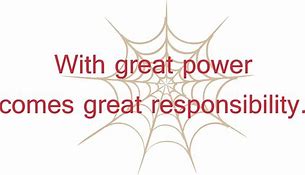Getting Your Act Together
Initialization
The website opening page presented the site theme – we are our choices.
Making choices is an intellectual activity of an individual brain, an effort philosophers call thinking (2) responding to a “call” (1) also originating in the subconscious mind. Our target is confined to the significant sociotechnical system problems we call Category three.
“Thinking” underwrites choice making by comparing the knowledge about candidate fixes to a prioritized value system also held within the individual’s brain (3). Choices made that turn out to be good attest that high-stakes thinking took place. 1 2 3
The theme is so central to our life’s trajectory it is expressly connected to this page:
- Scope of page subject matter
- The logical couplings between theme, the sociotechnical system, and this page
Scope: This is the first page in a gallery of pages that comprise what we have learned by experience is GYAT, getting your act together. You should realize that GYAT is determined by recognition programs residing in the subconscious mind. In this case it’s what other people subconsciously compute about you that counts, your vote for yourself does not tally.
Connections: GYAT is used by others to decide if you’re trustworthy or not and the subconscious program runs to completion in a centisecond at first contact. Without being GYAT rated, there can be no high-stakes trust. No trust and the Plan B goal is unobtainium. The difference in effort between going with the social norms and getting your act together is enormous in kind and quantity. That is why angst blowdown came first.
When you GYAT your life changes. You cannot willfully control it. Others cannot avoid sensing it reacting to it. That is why, exactly, self-deprecation always works in your favor.

Getting Your Act Together
There are compelling reasons for taking the trouble to skill-up for coping with the ever-changing operational reality and its dysfunctional social systems.
For one, clinging to status quo is self-delusion. No condition can stay put. The 2nd Law is continuously changing everything to more disorder. Everyday life for you is facing change, kicking and screaming perhaps, but unavoidable and this reality is factored into our Stone Age genome. To maintain stability and security while entropy is increasing takes having your act on entropy extraction together. What else is the world scene today but the effects of maladjustment to the ever-changing operational reality?
The paramount reason for GYAT is more subtle. It came in our Stone Age genome package and it governs your social life. Your subconscious mind is endowed with a variety of recognition programs. Within three hours of birth, for one, the infant is already distinguishing its mother from non-mothers. When ducklings do it, it’s called imprinting. These recognition programs are so important to social behavior because they are run by your subconscious mind on automatic with neither your knowledge nor your permission. Event-triggered, they run their algorithm to completion in a centisecond on autopilot.
In social reality, the instant you appear on the scene you are “read” for GYAT. In the first centisecond, everyone in the area has decided whether or not you are GYAT as their basis for conducting social intercourse with you. If you are judged GYAT, you are classified as provisionally trustworthy. If you are measured non-GYAT, high-states trust for you is out of the question. Your instinct of reciprocity kicks in to seal the deal.
Take a moment and consider the productivity implications between a mutually trusting social environment and a mutually distrusting social environment – today’s norm. It’s hard to appreciate the huge difference it makes unless you have experienced it – think night and day. The chance that you can fool your evaluators or that they can fool you is pinned at zero. It doesn’t matter if you have all your merit badges on GYAT. You are being graded by recognition programs in the heads of your judges over which you have no control. Their determinations count, your’s doesn’t.
Other recognition programs decide if you are spaced-out on angst. Anyone whose free energy is commandeered by anxiety cannot also have his act together. That’s why angst blowdown is the first milestone and rest area. Realize that most of your social conditioning was designed to leave you incompetent to manage change, a goal hardly aligned with your best interests in the digital age. “Don’t think, obey authorities.”
In these days of serious and worsening organizational dysfunction, the benefits from GYAT have been amplified. Since most people are now surrounded by folks who do not have their act together, while their recognition programs keep picking up on the angst, a GYAT person stands out in society as exceptional. This extra boost in GYAT value puts positive reciprocity in high gear. It’s a happy win win scene. The benefits stream and include goodies no one could have anticipated. The GYAT effect is in all your social transactions wherever they might be. It has the highest ROI of anything in social intelligence.
Silence-breaking about social intelligence a century ago
Verbatim excerpts: “Our social heritage consists of that part of our “nurture” which we acquire by the socialization process. Men have more social heritage than other animals` and are more dependent on it for existence. We have, indeed, become biologically parasitic upon our social heritage; and, if we once forgot what we have been taught, our species might die out before it had time to acquire a new social heritage. The mass of our social heritage is rapidly increasing, and the problem of securing economy in its acquirement and use, and efficiency in its continuous criticism and improvement, is urgent.
Part of our social heritage consists of the power, which we acquire by education from infancy onwards, of making sustained and conscious muscular and mental efforts. We learn to recognize the difference between will and impulse; and are thereby enabled to make continuous use of processes which are naturally intermittent, to invent methods of compensating for the resulting nervous strain, and to avail ourselves of the ” drive ” of creative impulse. Thought under modern conditions requires us to learn, not only how to stimulate artificial intellectual effort, but also how to use artificial intellectual methods. These methods have hitherto been most successful in the physical sciences.
Group coöperation under modern conditions, requires (like individual work and thought) a combination of socially inherited expedients with biologically inherited instincts. Men are a loosely gregarious species who instinctively used significant cries even before the invention of language; and they naturally coöperate by a clamorous alternation of the impulse to lead with the impulse to follow. Our socially inherited expedients of group coöperation by discipline and discussion are still imperfectly worked out, and are apt at any moment to break down, and their place to be taken by the primitive instinctive process. National coöperation is more dependent on our social heritage than group coöperation. In a group, men think and feel about direct sensations and memories of their fellows; in a nation, they must think and feel about some entity of the mind. At present we generally leave the formation of the mental ” panoramas” which represent our nation for each of us, to chance, or to the scheming of professional manipulators of motive.
We should make the formation of a trustworthy idea of our nation into a conscious process. Our idea when it is formed should remind us of the facts of the human type, of the differences between individual human beings, and of the quantitative relation between the grades and kinds of difference. Such an idea will help us to realize that a modern industrial nation is not likely to be permanently coherent unless habit is based on contentment; and unless contentment is made possible by an approximation to social equality, by a clearer understanding of economic facts, and by a greater liking in each of us for his work, that liking will only be secured under modern conditions if our social organization and our educational methods are based more on the idea of difference than on the idea of identity.
During the nineteenth century the industrial nations of the world directed their large -scale coöperative activities by two main expedients, the territorial state and capitalism. Both expedients are now widely distrusted. Vocational organization is in many ways useful, but when it is proposed to make vocationalism the main source of social power we must examine its tendencies in the present and its history in the past. Does guild socialism offer us a sufficiently varied and interesting life?
Is it compatible with “integration of labor,” when that process is socially desirable, or with the sufficient accumulation of capital for future work? On all these points our experience in the war indicated that the modern democratic state tends to take the more socially desirable and the modern vocational organizations the less socially desirable side.
The problem of vocational organization as a socially inherited expedient can be approached with less prejudice by examining the professions than by examining the Trade Unions. The profession of the law is the most powerful of the English vocational organizations, and shows the difficulties and dangers of uncontrolled vocationalism most clearly. The organization of the medical profession is more recent, and yet reveals important intellectual and administrative defects. Military professionalism has a history as old as civilization, and its dangers are obvious. The professionalism of teachers is peculiar in its relation to the special but intermittent teaching instinct, and in the relation between the process of teaching and learning and the whole of our social heritage of new and old knowledge.
The notion of Liberty may be seen in the results which follow from the obstruction of human impulses. Those causes depend more on the obstructing cause even more than on the nature of the obstruction. obstruction by human agents produces a different reaction from that produced by obstruction by non-human causes; but this unfreedom reaction is only produced when obstruction is felt to be an interference with the normal course of human relations.
The change of scale from national coöperation to world coöperation involves a change in the coöperative process. Our coöperative instincts of defense may here act as a cause of international hatred. But world coöperation is necessary if the human species is to survive; and the chief hope of world -peace lies in a recognition of that fact, leading to the effort of rational calculation and calculated action. For that purpose we must bring a new “problem-attitude” to bear on such sciences as logic, history, law, and biology, and on such principles as Liberty, Independence, Nationality, and Equality. We must also make an effort of invention in the adaptation of national institutions to world purposes and in the creation of new world institutions and traditions.
It all leads to the old dilemma of free will and determinism . We may someday escape from that dilemma; but meanwhile it has an unfortunate effect on our conduct. Our simpler motives seem to us more “scientific” that other motives. Darwinian determinism has made wars more likely; and psychological determinism is apt to diminish personal initiative and responsibility in a modern democracy. We should not allow either the physical scientists or the metaphysicians to divide the facts of human motive into those which are ‘scientific,’ and those which are not.”
GYAT and social status
It is essential for the MitM to recognize that his keystone role is shaped by natural law, mathematical physics, not opinion. His role is instrumental to social system success. The role of the keystone can neither be eliminated nor bypassed. Thousands of attempts by management to do this were unmitigated failures. That’s natural law at work. With no social status to lose, the MitM/keystone is completely and solely responsible for his performance. No other level in the hierarchy has that distinction. The upper classes are constantly engaging zero sum competition over higher authority, an opinion. The grounders can only gain social status when their foremen are gaining social status by performance. GYAT is a tide that raises all boats.
The entitled consumers, the upper class, are never directly in control of their social status. The producers are in full unilateral control of their social status. All they have to do is produce and get better at it. The assays formed by tracking performance data take care of themselves.
All the problems of the world could be settled easily if men were only willing to think. The trouble is that men very often resort to all sorts of devices in order not to think, because thinking is such hard work. T.J. Watson (IBM)
Moving on
Angst-free, you finally have enough internal energy available to invest in advancing towards your Plan B wellbeing by Getting Your Act Together. GYAT is a different kind of beast than angst blowdown. It takes longer to attain and its cognitive demand will deplete your cranium’s limited trickle-charge supply of glucose more than once. If that phenomenon hadn’t happened to you many times, you would never have found this website.
Experience has shown the best way to GYAT is to first build a knowledge platform which will support the myriad connections that have to be made. GYAT, massively cross-disciplinary, often finds itself above the mentor line. The GYAT platform covers topics that must be comfortably understood at the outset. Including:
- Subconscious mind’s dominant role
- Cause and effect proofing tools
- Distinguishing system issues that require the process of elimination to fix
- Allocation of effort, choice-making sociotechnology
- Context channels social behavior
- Recognition and appreciation of natural law
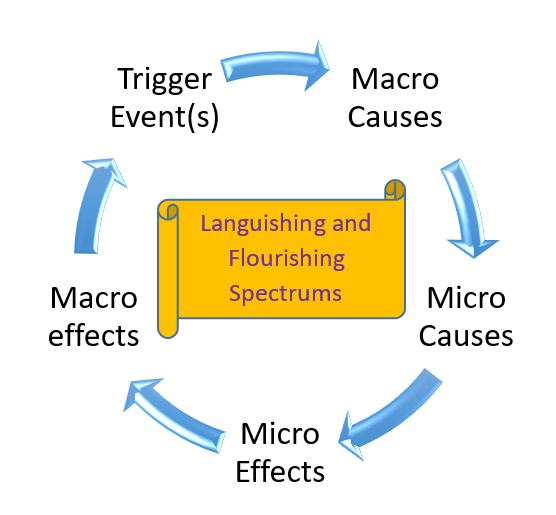
The “cause and effect” coupling is highly significant to navigating your way of life to self-fulfillment, self-actualization. Knowledge of the coupling provides basic guidance for choosing your daily doings. Solving your tough problems requires reliable and adequate understanding of their causes and effects. For organizational behavior, there are many causes of various strengths, often fractal. The consequences of organizational behavior, both good and bad, cascade and multiply from cataract to cataract. There is no stop rule for either causes or effects.
GIGO ruins problem-solving chances, and no one can GYAT unless he is competent at solving problems. If your assessment of effects is untrustworthy, if you don’t have enough actionable-quality information (AQI), finding the efficient causes is problematic. If your assessment of causes is deficient or defective, finding the real causes requires the process of elimination. As one example, for the last two centuries management has attempted to control workforce productivity by financial incentives. Each attempt has failed and in every case management response is to try yet another cocktail of financial incentives. Disregarding feedback is very unprofessional, irresponsible.
The flow of knowledge development and logic requisite to reach and preserve GYAT status:
- Basics, Flow, Dynamics and Validation, Benefit auto-expansion
- Flow starts with what we call “The Front End” an assault on gross ignorance
- Dynamics spans the activities of uncertainty elimination
- Automatic benefit expansion includes husbandry, positive reciprocity, and competitive advantage
In general what is taught in school about discovering and validating cause and effect is limited to issues where both the cause and the effect are below the mentor line (ML), that is, simple causes and simple effects, and proven remedies. The Establishment places the ML where it chooses using its financial clout, so that the causes of the horrendous consequences it delivers to society are usually above the zone of permitted inquiry and investigation. That is why, exactly, the system sciences never got off the ground. That is why, exactly, the social sciences never get near the causes of incoherent organizational behavior, in a gross failure of responsibility it has to society first voiced over a century ago.
It is easy to discern those causes of organizational dysfunction that are rooted above the ML. Those couple with the seriously harmful effects that persist, unmitigated, generation after generation. Examples include:
- Not learning from history
- Creating class distinctions
- Drive and aggression against their own producers
- Having losers
- Attempting to defy natural law, humankind is immune
- Attempting to defy human nature, humankind is immune
- Social conditioning to mindlessly obey authority
- Hostility towards curiosity, learning, creativity, and change
- Hostile towards non-interference
- Indifferent to the amount and scope of the wreckage caused
Since practically all root causes of persistently bad, lose-lose social behavior are situated above the mentor line, the Establishment is powerless to fix itself. Since the socialized victims do not venture above the ML to discover and address primary causes, (the bogeyman will get you), it’s lights out. This progressive degeneration process is on display worldwide now. As Starkermann computed with his dynamic simulations of social behavior, degrading a social system is fast and furious aggression, a nobrainer. Building a prosperous social system is slow and benevolent, an accomplishment that makes incessant demands on the intelligence in your conscious mind.
It is important for you to understand this ubiquitous pattern of behavior. No one has any rational reason why a benefactor would punish his producer, nobody, especially when the benefactor has to request services for his needs soon after berating his provider. This common scenario is lose-lose in the extreme. Examples are provided by your government, your school board, and even your spouse. Those who practice this self-defeating gambit have no access portals for reason to engage.
Even if the point of punishing the producer of your necessaries could be proposed, it would be easy to test for validity. The fact remains this behavior is lose-lose and greatly damaging to relationships – and it doesn’t get fixed by making believe it isn’t going on. An “Elephant in the room” classic.

Putting your conscious mind to work in your behalf
While getting your act together so you can leverage the trust it takes to flourish is very rewarding, it is a dramatic switch from getting by on your intuition to advancing goalward via your cognition. Your high-effort, glucose-sucking conscious mind has to intervene and take charge of your efforts because your powerhouse subconscious mind doesn’t have the necessary functionality to get your act together (GYAT). Its decision-making cycle time is much too fast to allow for fact-checking, error removal, and making coherent, logical choices based on evidence. If it needs data to justify its choice, it makes it up (GIGO). It always did.
This well-researched conundrum puts you in a precarious position. If you take the path of least cognitive effort, the path of least organizational resistance, AKA business-as-usual, trusting your intuition, you will fail.
As mentioned above, there is an unavoidable, menacing obstacle in the way to GYAT. Your GYAT scorecard is continuously tallied by others and, until their subconscious minds agree you have it, you don’t have it. You are being evaluated for mental togetherness by others in the first centisecond of interaction and they, not you, sign your GYAT card. Unlike most other failures, it is impossible to cover up for failing a GYAT check. Has anyone ever fooled you? For long?
Having your act together is central to good mental health, gateway to good physical health. The statistics on the connection are voluminous and incontrovertible. In 1910, 90% of the producing population, mostly farmers, considered themselves mentally healthy. In 2021 that number had lowered to 30%. The psychotherapy industry is booming with the victims of authoritarian abuse and the issues that attend languishing. The fact that 70% of the ruling population suffers from the imposter syndrome doesn’t help matters either. Many serious physical health issues are related to protracted psychological stress due to the demonstrable fact that business as usual can’t solve significant problems.
No society can flourish when the far greater part of the members are poor and miserable. Adam Smith
When you reach GYAT, everyone’s attitude towards you changes and your subconscious mind recognizes that milestone immediately. After all, your subconscious mind receives, interprets and regulates all of your senses. Your Stone Age genome came with all the templates for choice-making about GYAT already installed. Infants just a few hours old are already doing it.
For MitMs, your GYAT score is largely based on your performance in getting good things done, your problem-solving competency over time. When you consistently handle tough problems, especially those that baffle others, your GYAT card is signed. That category of problem always involves complexity and multiplicity of causes and effects.
Your expertise in handling multi-dimensional causation is the key to GYAT building. It is also a direct measure of your intelligence. People who consistently fail to solve important problems cannot also be called intelligent. People that consistently make choices that pan out in the operational reality cannot be called unintelligent. This poses big problems for the self-image of class-conscious entitled authoritarians. Their response is not to GYAT themselves but to sabotage high performers in the “inferior” classes.
Bottom line, the path to GYAT grade includes competency in cause/effect determination in non-obvious cases, a creative competency not taught in school. Being skilled at cause/effect determination of cases above the mentor line, always cross-disciplinary, places you in a special category in the subconscious mind of others – the Go-To Man. They can bring their difficult problem to you to solve without jeopardizing their social status by stepping up to the plate and solving it themselves. When they do enlist your services, reciprocity, an instinct, grants you positive social power.
Because this skill set is essential to GYAT, you must function above the mentor line. Your social system doesn’t want you to know what’s in this region. It takes a comparison of validated states of both flourishing and languishing to define either state. Being an expert in depression psychotherapy does not translate to expertise in flourishing.
The cause of flourishing is only validated as true when produced by a flourishing person, the wizard, who can take the languishing state and transpose it into a flourishing state, Oz. Whatever negative personal issues were possessed by the wizard, he kept his domain happy and content. That’s enough to qualify.
Causes and effects
The cause/effect domain of coherent reasoning covers a broad spectrum. At one end is simple one cause, one effect, never existing in nature. The other end features multiple, entangled causes and radiating, cascading effects. Like everything material in the universe, everything cause/effect is a function of time. The large asteroid that slammed into the Yucatan peninsula 65 million years ago examples a single cause with multiple effects, one of which was bringing on the age of mammals (us).
It doesn’t take much complexity in causation and the effects produced by the triggering event point nowhere towards the cause of the wreckage. Facts of effects, no matter how voluminous:
- Do not suggest or validate causation
- Do not delimit the full scope of the effects
When the knowledge of effects observed fails to implicate cause, it can’t guarantee inclusion all of the kinds of effects produced either. Opinion and intuition cannot alter your personal truth.
For most of the cause/effect spectrum, available information as consequences is used to guess at plausible causes. The first round of causes is always done by the subconscious mind on autopilot (intuition). Remember, everything in this arena is psychological.
Granted, the seat of the psychological-world is the individual cranium, a tangible, but its functional-reality duo is unknowable. Even if man had the wiring diagram of his brain, so he could intervene at the neuron level, he wouldn’t know where to begin.
Science looks for simple cause to offer a simple fix established within its discipline. It classifies the plausible causes it invents into groups that have known remedies. Science’s driving premise, the curse of reductionism, is that fixing each cause independently will restore the original condition unblemished. This is self-delusion at its zenith.
It is easy to draw the line where this popular strategy for causation fails because the problem of consequences it seeks to solve persists generation after generation. One example is the monotonous, manmade rise and fall of civilizations. That’s right, the exact same psychological system, its ideology, that built the civilization drove it to ruins. It never learned it had to change ideology to fit the environment to maintain its prosperity.
No strategy in the repertoire of cause/effect “science” addresses the messy part of the spectrum, where the big, significant issues of species survival lurk in ambush. Human creativity in surmising causes from material effects is far outclassed by complexity and multiplicity. In blunt terms, our brain is not powerful enough. That is why it took monstrous computer power for dynamic simulations of social behavior to help us arrive at Plan B.
Those causes that originate below the mentor line are in three categories:
- Cause of effect is direct, simple, beyond dispute. Knowledge of the effect automatically couples with the cause.
- The effect has multiple nonobvious causes but included within a single discipline scope. Both cause and effect are below the ML.
- The effect has multiple nonobvious causes and effects that are cross-disciplinary and knowable only by a cross-disciplinary mindset. Even so, knowledge of effects by itself points nowhere. Finding root causes in multiplicity requires the process of elimination (POE). Causes can only be certified after they are identified.
Material effects are always below the ML and measurable. Effects that appear above the mentor line are unknowable to those below. The assumption of a simple fix for the “root cause” is fallacious on its face.
Since Plan B has components far above the mentor line, the causes in the Plan B driver’s seat can only reside there. Once again, discovery requires the process of elimination. It’s a task that took decades and millions of dynamic simulation experiments. After eight years of Plan B success, the answer book of causes allows anyone to demonstrate the root causes in any setting. GYAT folks can create cause and predict its effect in any social setting on demand. That’s how we demonstrate Plan B functions.
Next up is the topdown breakdown chart of the languishing mode of organizational operations.
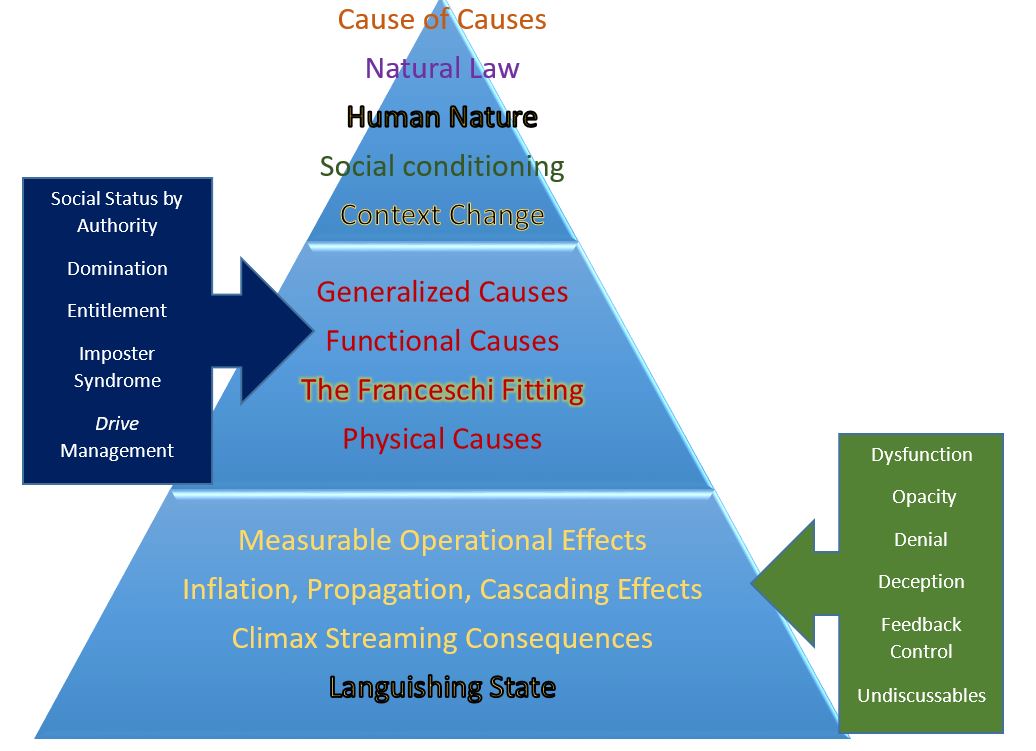
Next up is the topdown breakdown chart of flourishing organizational operations. Same structure different outcomes.
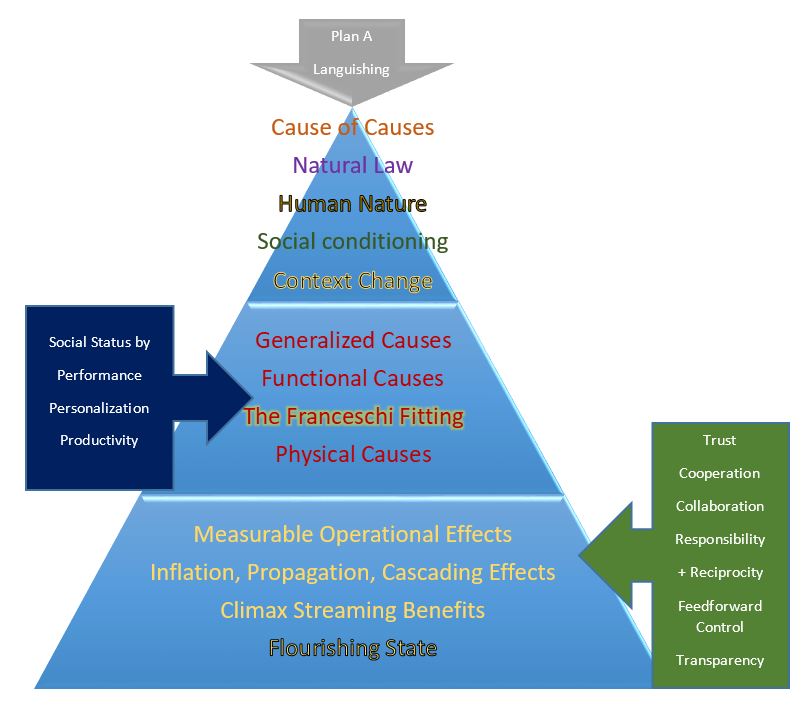
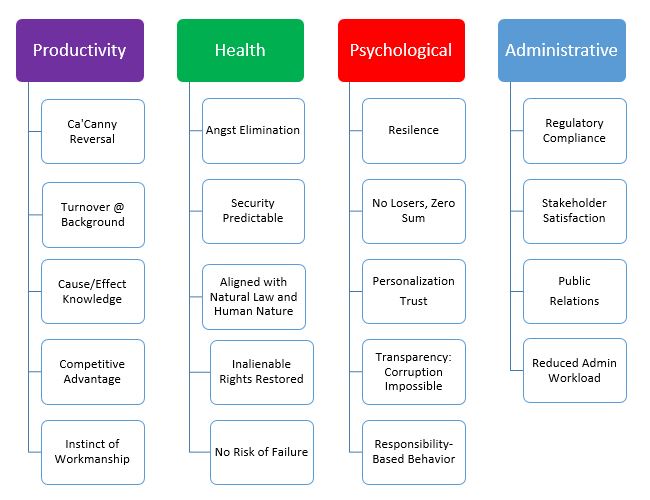
Cause and effect are rarely symmetrical. Causation of flourishing is validated only when produced by a person who can take keystones languishing and, using a transparent process, intentionally transpose the keystone level to flourishing. That is how, exactly, Plan B was validated in 2013.
Since everything is a function of time, it is a dimension in cause/effect and it is highly asymmetrical. Plan A is fast because the aggression at its core is fast (++). Plan B is slow because creating valid improvements is slow (+-). There is a kind of social behavior, mutual hostility, that is explosive (–).
In social behavior, as in zero sum transactions, aggression (++) takes the form of competition over authority. In benevolent +- social behavior, the individual wants to do what the other wishes would be done, the platinum rule. In hostile social behavior (- -), each party wants to do what will damage the other the most. All three of these aspects of attitude were first described in mathematical physics by Rudolf Starkermann in 1960. Each aspect has a role defined by control theory and there are no other aspects. It is as equally true in industrial process control as it is in social behavior, another matter in the scope of control theory.
The gargantuan unsolved problem posed by organizational dysfunction has causes above the mentor line and outside of all discipline scopes. A social system that is languishing has no chance to right itself by continuing its rule-based behaviors. Business as usual put it in languish mode in the first place.
The languishing institution cannot move toward flourishing on its own ideology. It has intuitions about the causes of its lethargy that are dead wrong. The consequent GIGO-based actions it takes are forms of punishment of the workforce. Counterproductive in the extreme.
The only method proven effective, one that can eventually lead to requisite understanding of the cause/effect situation is the process of elimination. The only way to validate that statement is to have confidence in the end target as attainable and try out candidate fixes. In our case we adopted Chris Argyris’ criteria as definition of flourishing success. The fix can only be validated by implementing the causes of prosperity, which must be generic, and deliver a flourishing social system.
Significant cause/effect issues, where both the causes and the effects are incompletely known, ends in ineffective responses. The odds of right action by chance are zero. Reliance on intuition is a sucker’s bet.
A reasonable facsimile of the Plan B process is “The Wizard of Oz.” Efforts of the wicked forces infuse fear into the foursome.

Enter the Interventionist, Toto, who shows the foursome that the threatening Wizard is a fraud.
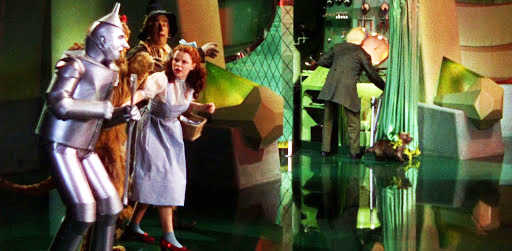
GYAT Platform Facts
- GYAT, or not is sensed immediately by all mammals, man’s dogs, and their young.
- Human nature is invariant across space and generations.
- Natural law is indifferent
- Social conditioning goals, part of our genome, are essentially invariant
- No one can learn this stuff for you.
- The basic laws of social behavior are generic
- “There is no try.” Yoda, No partial attainment of success.
- The subconscious mind always chooses task action first.
- You only have control over your efforts. Nothing else.
Establishment tools
The basic power tool of manipulation available to the Establishment is to plant and cultivate fear. We are socialized to obey authority, in place of thinking for ourselves, for herd security and to follow the rules from central command without questioning them – or be punished. So far, so good.
The menace plaguing the Establishment is the Second Law, about which even emperors can do nothing. In reality, change of everything material is continuous and fractal. “Entropy tends to a maximum” exerted its influence from the big bang on. So here we are, facing changed conditions all day long, socialized to ignore them. Comply with this axiom of hierarchical society, and in due course a disturbance to status quo will come along that brings extinction of the entire social system.
The healthy position, always, is to avoid attempting to defy a law of nature, especially the most secure natural law of the lot. To do this, you must acquaint yourself with the laws and invest cognitive effort. Experience with Plan B has shown several natural laws that have make or break power over the consequences of social behavior. Most people only know a handful and believe that Nature plays favorites, bending Her laws upon devout request, to suit a particular local situation the supplicant finds himself in.
When the power of hope and prayer to change things is scientifically investigated, nobody believes the negative results. That head-in-sand posture does nothing to solve the problem, growing bigger by the day. When it grows so big it can’t be hidden, the window of opportunity to fix the menace is already closed.
Plan B is all about competency with change, either fighting it off or bringing it about. It means having tolerance for errors and the many failures working the process of elimination. All else fails. When subject matter is perceived as significant and life changing as Plan B, if true, and no plausible excuse for rejecting it is available, catatonia is the subconscious-mind response. Demonstrable. Even the atomic bomb was less fearsome than Plan B existence. Why would I stay and suffer with Plan A? Is a puzzlement.
Plan B represents complexity, novelty, and an immediate, direct personal impact. Once aware that Plan B exists, transposing to Plan B can’t be put off without incurring psychological damage.
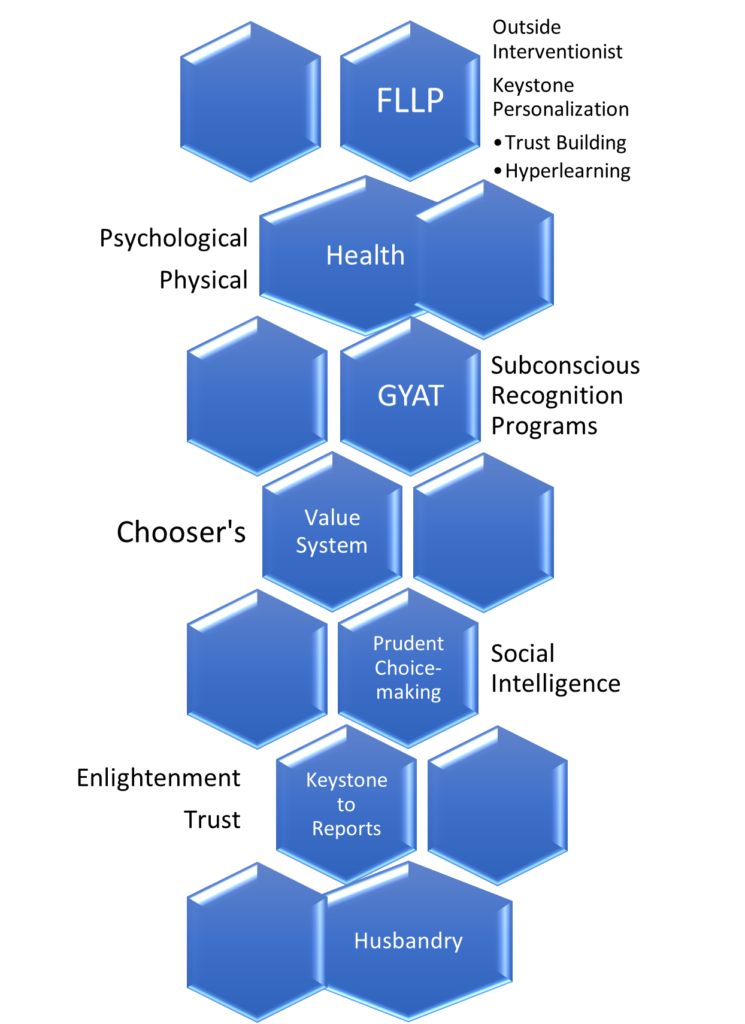
Views: 210


